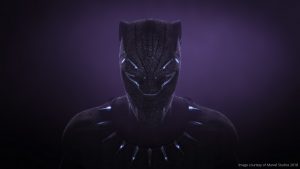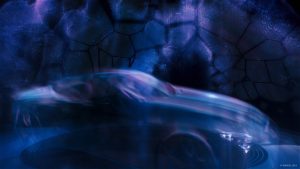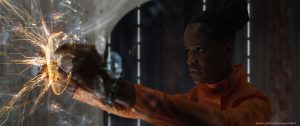Maxon Highlights Client Contributions to Oscar-Nominated Films
Story Highlights
Maxon congratulates clients Territory Studio, Perception, and Cantina Creative who relied on Maxon’s Cinema 4D software to create outstanding VFX sequences for films nominated for Oscars in this year’s Best Picture and Best Visual Effects categories. Highlights of the work done with Cinema 4D by these companies include the dazzling technology of the futuristic African nation of Wakanda in the blockbuster feature Black Panther, the fantastical 3D virtual environments portrayed in Ready Player One, and the complex FUI and HUD sequences in Avengers: Infinity War.
 “These elite studios represent the pinnacle of excellence in visual storytelling,” says David McGavran, CEO, Maxon. “We are honored that Cinema 4D plays an important role in their creative process, and heartily congratulate the artists and technologists whose stunning VFX work is among this year’s Oscar nominees.”
“These elite studios represent the pinnacle of excellence in visual storytelling,” says David McGavran, CEO, Maxon. “We are honored that Cinema 4D plays an important role in their creative process, and heartily congratulate the artists and technologists whose stunning VFX work is among this year’s Oscar nominees.”
Studios who contributed content using Cinema 4D to this year’s Oscar-nominated films for Achievement in Visual Effects and Best Picture include:
Black Panther – Best Picture Academy Award Nominee
Perception
The Perception team created key elements for Black Panther, including visualizations key to capturing the look and feel of vibranium, a fictional metal technology critical to the storyline in the film that takes on different three-dimensional shapes and forms and provides energetic qualities to the Wakandan universe, UI design elements for T’Challa’s Black Panther suit that is fabricated with vibranium, and princess Shuri’s ultra-high tech laboratory, a location that needed detailed designs to populate expansive screens and displays.
Perception was also responsible for previsualizing the opening ‘prologue’ animation detailing the history of Wakanda, relying on Cinema 4D to block out scenes, camera moves and to design the various visual metaphors seen. In addition, the studio leveraged the software’s Sound Effector toolset to fully animate and render the magical 2.5-minute end-title sequence featuring the song, “All the Stars” by Kendrick Lamar and SZA, to create moments where the vibranium sand pulses to the beat of the song.
“We used Cinema 4D in the earliest stages of concept development,” says John LePore, chief creative director, Perception. “Its ease of use allowed us to quickly experiment, envision and generate fantastic futuristic three-dimensional designs unique to Wakanda so that we could show even our wildest ideas throughout the creative process to the director and Marvel Studios team.”
 Cantina Creative
Cantina Creative
The Cantina Creative VFX team members were brought on board to help Marvel Production conceptualize the elaborate hologram graphics that appear throughout Shuri’s lab, T’Challa’s car, and diplomat and spy Everett Ross’ Ready-to-Fly ship. The team also defined specific HUD story beats for the ship that included telemetry and flight feedback data during Ross’ virtual flights. All animation was then packaged-up with a look frame and provided to other VFX vendors for compositing.
“The inherent flexibility in the Cinema 4D toolset gave the studio broad license to consider several creative approaches to help define the visual language in the film and deliver challenging sequences,” explains Stephen Lawes, Creative Director, Cantina Creative. “Drawing on the MoGraph module, X-Particles, and Take System for render efficiency allowed us to conceptualize and design authentic 3D hologram effects and computer screen diagnostics that would seamlessly co-exist in the Black Panther world as elegant textures and clearly represent critical story points for the audience.”
Ready Player One – Best VFX Academy Award Nominee
Territory Studio
Territory Studio’s creative brief on Ready Player One was to create rich graphic elements to support director Stephen Spielberg’s vision for the film. Working in collaboration with VFX studios’ ILM and Digital Domain, Territory relied on Cinema 4D as its primary 3D software from concept and early designs through 3D environment creation, projection mapping, animating, and lighting to final renders.
“The opening slit-scan inspired boot-up sequence for Ready Player One, in particular, where we follow protagonist Wade Watts’ point of view as he puts on his visor and logs in to the CG world of the Oasis was completely built in Cinema 4D using the Cloner, Xpresso and other features in the MoGraph toolset,” says Sam Munnings, designer, Territory Studio. “This sequence bridged the real world shot by Digital Domain with the virtual world, meticulously created by ILM. Ready Player One offered us a good amount of workflow hurdles dealing with two distinct pipelines which Cinema 4D dealt with tremendously to quickly and easily address any feedback the director had.”
 Avengers: Infinity War – Best VFX Nominee
Avengers: Infinity War – Best VFX Nominee
Cantina Creative
For Avengers: Infinity War, Cantina was tasked with creating Tony Stark’s (Iron Man) HUD designs and executing the challenging hologram contents that helps explain how Shuri disconnects the Mind Stone from the physical body of Vision. Working from a 3D model of the Mind Stone provided by Marvel Studios, all the 3D tracking data was passed into Cinema 4D where the stone was animated and retextured to fit within the look of the hologram. The creative team also designed the initial holographic scan of Vision prior to the digital operation.
“Even though we had a modest shot count of 87 in Avengers: Infinity War, harnessing the power and versatility of Cinema 4D we were able to create multiple versions of sequences easily and concentrate on the creative aspects without getting bogged down in the technical,” outlines Lawes. “Working in concert with ILM trading tracking data and shot progressions back and forth, the software was a key ingredient in working efficiently.”
Territory Studio
For Marvel Studios’ Avengers: Infinity War, Territory Studio’s San Francisco team, led by Marti Romances, creative director, worked directly with production designer Charlie Woods, to deliver 130 animated screens for on-set playback and UI interface elements for the new Guardians of the Galaxy spaceship and Escape Pod, Avengers Compound, and several other sets and elements.
“Cinema 4D was essential to designing and animating all of the visualizations for the Guardian’s spaceship screens that included wrapping graphics on the large curved glass windshield,” says Romances. “It was also helpful for quickly rendering multipass animation sequences using MoGraph, tracers and all of the usual tools we use in Cinema 4D to portray weapons for the gunners, thrusters for the engineers, and design concepts for the HUD’s on the Escape Pod.”
